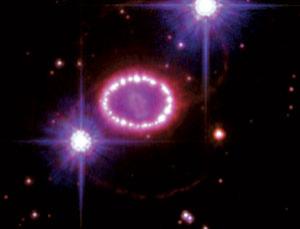
A new kind of star may be lurking in the debris from a nearby supernova explosion. If confirmed, the "quark star" could offer fresh insights into the earliest moments of the universe.
When supernovae explode, they leave behind either a black hole or a dense remnant called a neutron star. However, recent calculations suggest a third possibility: a quark star, which forms when the pressure falls just short of creating a black hole.
Astronomers believe these form after the neutron star stage, when the pressure inside a supernova rises so high the neutrons disintegrate into their constituents - quarks. These form an even denser star than neutrons.
Observing a quark star could shed light on what happened just after the big bang, because at this time, the universe was filled with a dense sea of quark matter superheated to a trillion °C. While some groups have claimed to have found candidate quark stars, no discovery has yet been confirmed.
Now Kwong-Sang Cheng of the University of Hong Kong, China, and colleagues have presented evidence that a quark star formed in a bright supernova called SN 1987A, which is among the nearest supernovae to have been observed.
The birth of a neutron star is known to be accompanied by a single burst of neutrinos. But when the team examined data from two neutrino detectors - Kamiokande II in Japan and Irvine-Michigan-Brookhaven in the US - they found that SN 1987A gave off two separate bursts. "There is a significant time delay between [the bursts recorded by] these two detectors," says Cheng. They believe the first burst was released when a neutron star formed, while the second was triggered seconds later by its collapse into a quark star. The results will appear in The Astrophysical Journal.
"This model is intriguing and reasonable," says Yong-Feng Huang of Nanjing University, China. "It can explain many key features of SN 1987A." However, Edward Witten of the Institute for Advanced Study in Princeton, New Jersey, is not convinced. "I hope they're right," he says. "My first reaction, though, is that this is a bit of a long shot."
High-resolution X-ray observatories, due to fly in space in the next decade, may have the final say. Neutron stars and quark stars should look very different at X-ray wavelengths, says Cheng.



"When supernovae explode, they leave behind either a black hole or a dense remnant called a neutron star. However, recent CALCULATIONS suggest a third possibility: a quark star, which forms when the pressure falls just short of creating a black hole."
Someone once proved mathematically that flight was impossible for objects havier than air.
No black holes ( [Link])or neutron stars ( [Link]) have ever been observed. Now lets suggest a third unproven calculation.
Explore electric universe